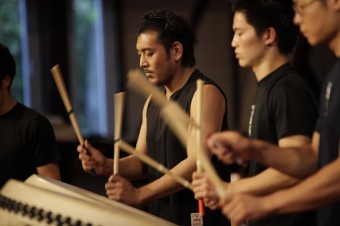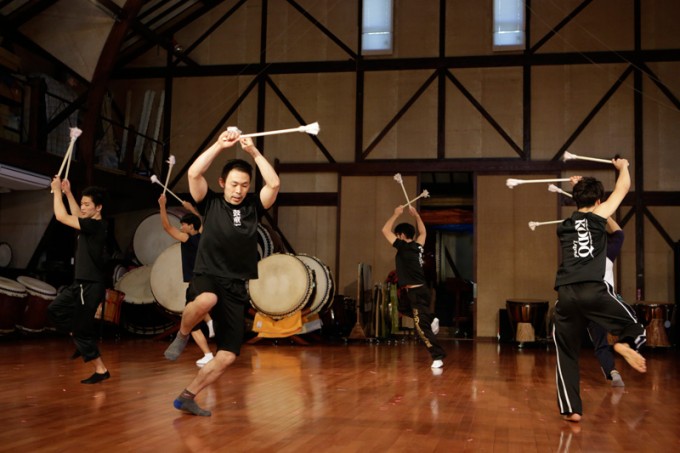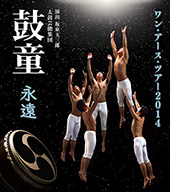Kodo Rehearsal Report: “Eternity,” the Origin of Kodo and Taiko –Part 3–
“Eternity,” the Origin of Kodo and Taiko –Part 3–
Original Japanese Article by Koichi Imai (Freelance Writer) ● Photos by Takashi Okamoto
“What is Wadaiko?”: This Simple Question Opens Doors to New Possibilities
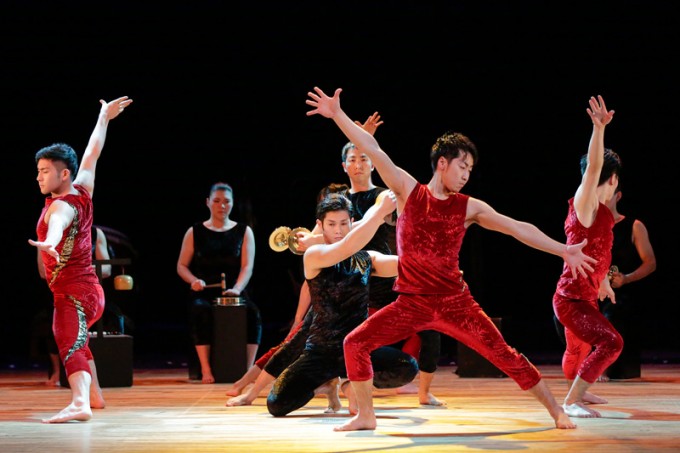
The second half of “Eternity” also started with the orin gong. This perhaps acts as a charm to transport the audience into another world. An ensemble of chappa (small cymbals) and bells are played at the opening. Four performers slip out of the ensemble to begin dancing in an arrangement that feels at once ancient and contemporary. They invite the audience to enter another dimension along with the mysterious melody of the chappa and gamelan (Indonesian percussive instruments).
Transported to another dimension, you encounter Takibi (composed by Yosuke Oda). It is a very unique piece, which will shatter your established ideas about taiko. Five performers trace the rims of the taiko with their drumsticks as they draw circles, tapping them as they go around. It is in using every element of the taiko like this that they are able to create sounds and rhythms beyond traditional taiko. At risk of being misunderstood, I would almost say I feel like I am at a “Stomp” performance, in which the players use brooms and metal drums as musical instruments. I can’t believe that I am listening to the taiko. It is well known that Stomp was heavily influenced by Kodo, and it is in this moment I understand that Kodo represents one of the top percussion performances in the world and the taiko has tremendous possibilities.
“When I thought of ‘eternity,’ I felt the need to travel backward in time,” explains Yosuke Oda. “Eternity spans not only into the future, but also the past. So I tried to imagine taiko before its present playing style was established and decided not to use common taiko rhythms. Some people today may say that what we are playing is not ‘taiko,’ but no one knows how the instrument was actually played in ancient times. The idea of ‘common’ taiko playing was made after a basic taiko style had been constructed.”
Oda arrived at this idea through his experiences in “Legend” and “Mystery,” once he had grasped what the Artistic Director, Tamasaburo Bando, was hoping to achieve. Tamasaburo’s ideas could be similar to those that he applies in Kabuki, not only as a traditional performance, but also as a modern form of expression. When Oda, who is a core figure in the Kodo ensemble, comes up with such a liberated idea, it is bound to have great influence on other members.
Soon after, the performers appear holding and swinging long sticks with tassels and they dance to the melody of the shinobue (bamboo flute). As they circle around and around, they naturally fall into position in front of the large hirado-daiko (large drums). First one hirado-daiko is played, and then three, and the number of performers slowly increases. The Artistic Director considers the overall formation, the intentional pauses, and the flowing movements as paramount to the piece, and this aesthetic is shared carefully with all the performers.
“When I heard the title, ‘Eternity,’ the idea of something spinning came to mind,” explains Mitsuru Ishizuka. “I wanted to work with this inspiration, so first I spun the drumsticks, then I spun my body on its axis, and finally I whirled myself around the taiko. Seeing this, Tamasaburo suggested that I increase the number of taiko. In this movement around the drums, I didn’t want to just be spinning in space, but to somehow express how this spinning movement could almost lift the performers up off the stage and elevate them into space like a whirlwind. I think the result portrays something like the gravitational pull of planets in the solar system.”
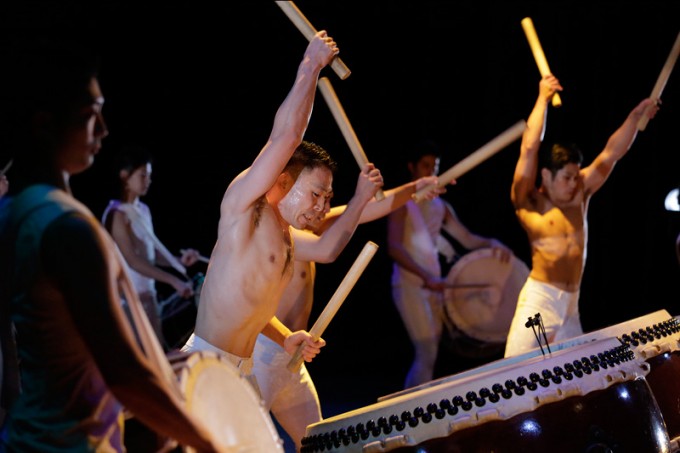
Then, the familiar world of taiko unfolds. Powerful rhythms reign. The Kodo members seem to be at once united with taiko and also battling against the drums. At this instant I realize that Yosuke Oda and three other performers are pounding the taiko with their bare hands. I imagine this was probably a playing style from times past, a special kind of communication that could only be conveyed through a battle with the drums. The taiko goes through a wide array of expressions before culminating in a moving finale. The performers play with continuous brute force until the very last beat.
▶Watch on YouTube http://youtu.be/8_BHh_OyRVs
Kodo One Earth Tour 2015: Eternity
June 6 (Sat) Ryutopia Concert Hall, Niigata City
June 7 (Sun) Joetsu Bunka Kaikan, Joetsu, Niigata
June 17 (Wed) Sagami Women’s University Green Hall, Sagamihara, Kanagawa
June 19 (Fri) Yokosuka Arts Theater, Yokosuka, Kanagawa
June 20 (Sat) Chigasaki Shimin Bunka Kaikan, Chigasaki, Kanagawa
June 26 (Fri) Pastoral Kazo, Kazo, Saitama
June 27 (Sat) Mikabo Mirai Kan, Fujioka, Gunma
June 28 (Sun) Kimitsu Shimin Bunka Hall, Kimitsu, Chiba
July 3 (Fri) Shin-Kabukiza Theater, Osaka City
July 4 (Sat) Shin-Kabukiza Theater, Osaka City
July 5 (Sun) Shin-Kabukiza Theater, Osaka City
July 7 (Tue) Matsumoto Performing Arts Centre Grand Hall, Matsumoto, Nagano
July 11 (Sat) Kyoto Performing Arts Center Shunjuza, Kyoto City
July 12 (Sun) Kyoto Performing Arts Center Shunjuza, Kyoto City
July 17 (Fri) Yawatahama-shi Bunka Kaikan Yume Mikan Dai Hall, Yawatahama, Ehime
July 19 (Sun) Miyoshi Shimin Hall, Miyoshi, Hiroshima
http://www.kodo.or.jp/oet/index_en.html#schedule17b
Koichi Imai (Freelance Writer)
Koichi Imai became a theater afficionado during his college years, and graduated from Nihon University College of Art. He went on to spend sixteen years working for “Theater Guide” magazine in Japan. Next, he assumed a public relations role at Matsumoto Performing Arts Centre, where he worked for over five years before becoming a freelance editor and writer. Based in the Nagano area, his current work focuses on theater, as well as artists, artisans, and farmers. He is also involved in organizing various events.




